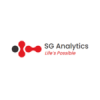Leaders with successful online marketplaces and client acquisition campaigns state that valuable insights into customer behaviors need to be developed in order to stay ahead of the game. Hence, businesses can no longer rely on elementary demographical data. Rather, they must invest more effort in understanding how customers think, what drives their actions, and the way they interact with products or services.
This necessity has led to the rise of behavioral analytics, which now uses alternative information to gain deeper insights into client behaviors and motivations. Today, businesses can deliver personal experiences precisely aligning with individual preferences using those insights. That is why they can foster loyalty and growth with the power of behavioral analytics. This post will explain the significance of customer insights that behavioral analytics may offer to aid in personalization.
Understanding Behavioral Analytics and Consumer Insights
Behavioral analytics is defined as the study of how customers conduct themselves while using a product or service. It goes beyond the “who,” elaborating on what customers do, how often particular features are used, and what actually triggers these actions. For these purposes, relevant customer analytics techniques look into real-time data from diverse sources. These sources can include the following:
- Website clicks,
- Mobile app activity,
- Social media engagement,
- eCommerce behavior.
This technology helps a business find patterns, predict what a customer will do next, and make better decisions to improve the customer experience (CX). With such data married with demographics and history of purchases, leaders acquire an overarching assessment of the customer journey that their companies use to tailor the content, products, and services. Ultimately, every brand wants to provide customers with more relevant and consistent offerings using those insights.
Why Does Behavioral Analytics Matter in Personalization Strategies?
The advancements in behavioral analytics methods introduce a new age of personalization in business. Instead of marketing repetitive messages based on some one-size-fits-all strategies that do not work as they once did, organizations must recognize that customers today are expecting brands to understand their unique preferences and then target delivery to suit those needs. Multiple studies frequently show that most consumers think they will buy more from a company if it provides a tailored experience.
Behavioral analytics is a powerful tool that may help businesses fulfill those expectations through very valuable insights into how customers actually engage with the brand. It answers such questions as:
- What types of content do customers find the most interesting?
- How do customers navigate through a website or application prior to a purchase?
- Which features or products are of most interest to specific customer segments?
- What are the factors that cause customer drop-off or churn?
It enables businesses to design even more personalized and relevant interactions that keep attracting customers, often bringing them back for more. For instance, companies can employ generative AI chatbot development solutions to streamline how customers request helpdesk features, compare distinct product versions, and offer feedback.
The Pillars of Behavioral Analytics for Customer Experience Personalization
1. Enhanced Customer Experience
The biggest advantage of behavioral analytics is precisely the enhancement of the overall customer experience. Tracking how users interact with a brand’s website, application, or services will help reveal areas in customer journeys that need to be solved relatively quickly for the users.
For example, if lots of customers drop off in one place during checkout, behavioral data will mark this as a problem and, therefore, recommend optimization ideas to enhance that part of the CX.
One of the powerful ways of retaining customers is through personalization. Customers are more likely to be retained as loyal customers for the brand if they are appreciated and understood. This experience will become a reality through predictions of what customers want and need, sometimes even before they even know it, thanks to behavioral analytics.
2. Effective Targeting and Segmentation
The traditional approach to marketing targets main categories, such as age or location, which are subsequently targeted with the relevant messages. However, these segments merely reveal the broad dimensions and cannot be used to offer a more detailed and individualized approach. Behavioral analytics improves this by making it feasible for businesses to segment their target customers based on their behavior and preferences.
An e-commerce company will use behavioral analytics to develop segments of frequent browse customers who have browsed a certain product category but haven’t bought anything at all.
Based on that knowledge, the company can engage that customer segment with targeted promotions or even recommendations of relevant products that they are likely interested in buying. Companies will find better engagement and conversion when marketing efforts speak specifically to certain behavioral patterns.
3. Predictive Insights for Proactive Engagement
Probably one of the most exciting aspects of behavioral analytics is its ability to predict. From historical data and machine learning algorithms, businesses can predict how their customers are going to behave in the future. This means businesses will be able to foresee when a customer will need something and take action before that need arises.
For example, if behavioral data suggest that a specific customer is likely to reorder a specific product every three-month cycle, the firm may remind the customer when the next expected order is approaching or offer them a price discount.
In the same way, business companies can predict when a customer will churn based on declining engagement levels and target them with offers that can re-engage the customers. By using predictive insights, businesses can improve personalization while also increasing the strength of customer relationships and reducing churn.
4. Development of Product Optimization
In behavioral analytics, several activities have a very significant impact on product development strategies. How the customers interact with certain service features or products can be analyzed to provide valuable feedback about what works and what fails.
For example, an automobile company might utilize behavioral analytics to understand its most used features and compare them with the least vehicle components. This information will be helpful for future production updates and improvements to suit customer needs and preferences during the design phase.
In addition to enhancing existing goods, behavioral insights offer remarkable aid in innovating new products or services. When multiple searches for a product or service fail to yield the desired results, those consumer queries can be an innovation opportunity for your enterprise. Therefore, companies must capitalize on such gaps between unique demands and current market unavailability to establish new trends in the marketplace.
Conclusion
The one-size-fits-all marketing era is gone. It is a story of the past, suggesting that today if businesses wish to survive, they need to provide experiences that resonate with each of their customers. Bringing deep visibility into customer behavior insights via analytics is indeed integral to unlocking novel competitive strengths.
With the astonishing advancements in technology, we can expect more all-encompassing behavioral analytics integrations. In addition to that, with AI, machine learning, and real-time data analyses, businesses will be able to provide hyper-personalized experiences at scale. The ability to recommend the perfect product, predict customer needs, and optimize the customer journey at the whole level will define the future of customer engagement through behavioral analytics.


